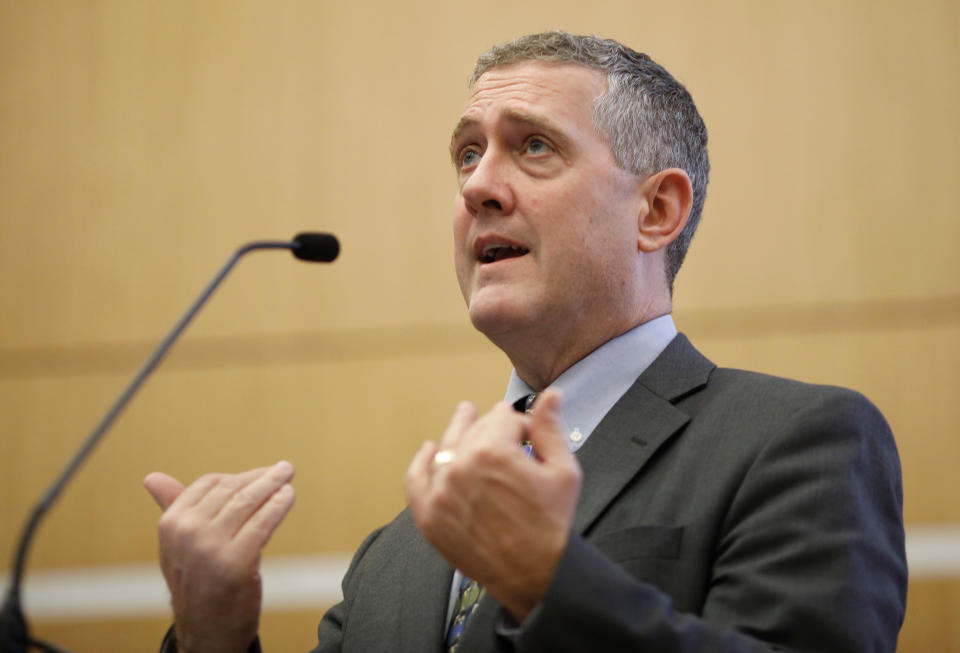Fed faces questions on ‘data-dependence’ heading into possible rate cut
The Fed looks poised to cut rates for the first time in over a decade in its next policy-setting meeting on Wednesday. If it does, Chairman Jerome Powell may have to clarify his explanation of “data-dependence” as the central bank weighs future moves.
Key data points appear to have improved since the Fed’s June meeting where it held rates steady, meaning that Powell will be closely watched for how he justifies easing policy if the Federal Open Market Committee does cut rates at the conclusion of Wednesday’s meeting.
UBS wrote July 24 that Powell “clearly wants to cut rates” and pointed to “downplayed” commentary from Fed speakers over the strength of data received since June.
“This data independence speaks of a desire to cut rates independent of the current state of the U.S. economy,” UBS said.
An estimate-beating June jobs report and GDP print, in addition to data pointing to a robust consumer, have raised questions about whether the data truly warrant a need for lower rates for the time being.
Fed Vice Chairman Richard Clarida, who leaned on the “data-dependence” phrasing beginning at the end of 2018, has said the Fed does not need to wait until the “data turns decisively” before moving on rates.
For the Fed, telegraphing a coming rate cut as an “insurance” cut requires some judgment that data may not reflect coming risks, which aligns with the Fed’s efforts to “act as appropriate” to sustain the economic expansion. But has the Fed’s messaging on a rate cut been so strong that it requires overriding short-term observations in the data?
Communicating a cut
As of Monday afternoon, markets were pricing in a 76% chance of a 25 basis point rate cut, with a 24% chance of a 50 basis point cut.
UBS is one of the few shops on Wall Street predicting a 50 basis points on Wednesday. UBS said Clarida’s speech right before the Fed blackout began was an effort to amplify a strong dovish tone for the July meeting.
“Communication, not data, drives our call,” UBS wrote.

FOMC-voter and St. Louis Fed President James Bullard had an explanation along these lines on July 19. Downplaying the “good and encouraging data,” Bullard said the economy still appears headed for a slowdown and said policymakers need to deliver on the rate cut that it had signaled in June.
“You do have to ratify that at this point and follow through,” Bullard said.
Other analysts give more credit to the Fed’s sensitivity to data received since June. Nomura wrote July 25 that “strengthening” data reduced the case for a 50 basis point cut in favor of a 25 basis point move instead.
“We do not believe the economy is on the brink of a recession,” Nomura wrote.
Their note note pointed to voting members of the committee who some may consider hawks given their recent remarks.
Kansas City Fed President Esther George and Boston Fed President Eric Rosengren both hinted in recent weeks that the economy does not appear to need accommodation.
If the Fed lowers rates, George and Rosengren could both dissent if they feel it would have been more appropriate to hold rates steady at the current range of 2.25% to 2.5%.
Degrees of dovishness in 25 basis points
The Fed has another lever that it can move on Wednesday: the balance sheet.
If the Fed wanted to deliver only 25 basis points of cuts but send a slightly stronger dovish tone, it could also end its process of unwinding assets off of its balance sheet. Currently, the Fed is in the process of reducing its holdings of trillions of dollars of asset-backed securities and Treasuries that it accumulated to battle the financial crisis.
The Fed began “quantitative tightening” in late 2017 and had signaled earlier this year that the unwind would finish at the end of September.
But lowering rates may run counter to its goal of easier policy if it is still shrinking its balance sheet, which is generally associated with tightening conditions (although its impact on market liquidity is still being studied).
Powell left the door open to that possibility on June 19, saying “we’ll always be willing to adjust balance sheet policy so that it serves our dual-mandate objectives.”
Analysts are split on whether the Fed would also announce ending its balance sheet unwind early if it also cuts rates on Wednesday.
Goldman Sachs, expecting a 25 basis point cut, wrote July 22 that it expects the Fed to also announce that it will end quantitative tightening so that its actions do not “work at cross purposes.”
But Société Générale’s Stephen Gallagher, who also expects a 25 basis point cut, wrote July 25 that he does not expect the Fed to end the balance sheet unwind early since its planned end is just two months away.
“[A] a two-month speed up...may not be worth the mixed and confused communication after announcing wind-down plans earlier this year,” Gallagher wrote.
Brian Cheung is a reporter covering the banking industry and the intersection of finance and policy for Yahoo Finance. You can follow him on Twitter @bcheungz.
'Blew it!' Trump's Fed-bashing on Twitter escalates ahead of possible rate cut
Fed's jumbled messaging catches Trump's attention ahead of key policy-setting meeting
Why US regulators are struggling to step up to regulate Facebook's Libra
Congress may have accidentally freed nearly all banks from the Volcker Rule
Read the latest financial and business news from Yahoo Finance
